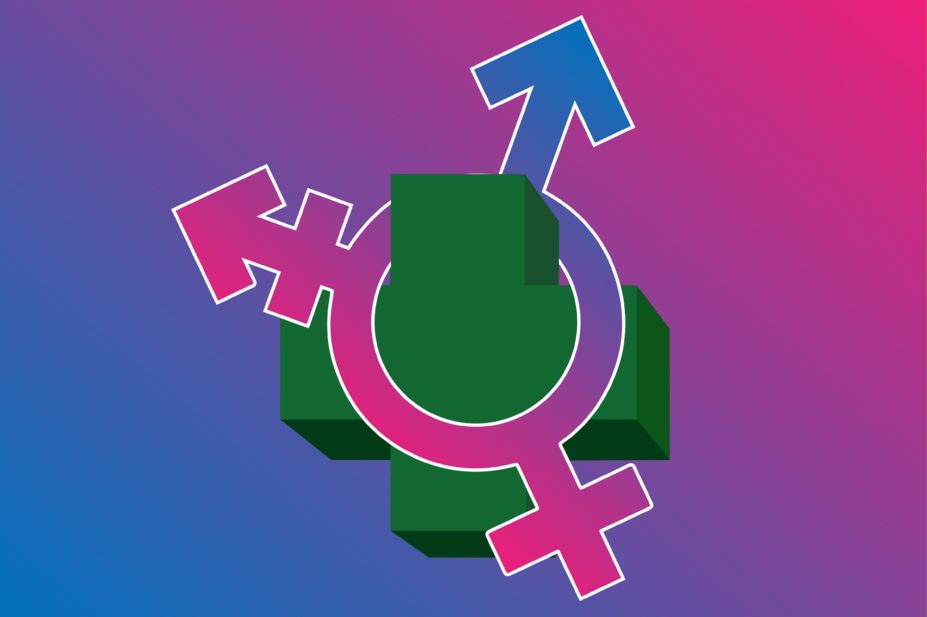
McLean
The government estimates that around 200,000–500,000 people identify as transgender in the UK, while Stonewall — a charity campaigning for the equality of LGBT people — suggests there could be as many as 600,000, including those who identify as non-binary (a spectrum of identities neither exclusively male or female)[1],[2]
.
Gender is a societal construct; its expression is dependent on the environment and culture in which the person lives[3]
. Gender stereotypes may give visual clues to a person’s sex, but not reliably. Some people may have gender dysphoria, a condition in which a person feels discomfort because their biological sex does not match their gender identity — these people may identify as transgender, and may or may not choose to transition.
Others may choose to be ‘non-binary’, which is to reject the two gender stereotypes. This is reflected in people’s preferred pronouns — for example, ‘he’, ‘she’ or ‘they’.
A person is not required to have had surgery or hormone therapies for the purpose of gender transition
Gender reassignment is one of the nine characteristics legally protected by the Equality Act 2010, which the Act describes as when a person is “proposing to undergo, is undergoing or has undergone a process (or part of a process) for the purpose of reassigning the person’s sex by changing physiological or other attributes of sex”.
This means that a person is not required to have had surgery or hormone therapies for the purpose of gender transition; “other attributes of sex” can mean living as the preferred gender. Therefore, a physiologically intact male can identify as a trans woman.
Quite rightly, society is becoming more aware of the transgender identity and the issues transgender people face, including stigma, discrimination and poorer access to NHS support[4]
. And more people are acting on their desire to transition: in 2009/2010, 77 referrals were made to the NHS’s Gender Identity Development Service, whereas in 2018Â/2019, the service received 2,590 referrals[5]
.
Since the Gender Recognition Act was implemented in 2004, 5,000 people have used it to obtain a gender recognition certificate for their preferred gender. To apply, a person must: have a diagnosis of gender dysphoria; have lived as their desired gender for a minimum of two years; and be receiving support from a registered medical practitioner or psychologist.
For those going through this process, it must be a tremendous relief to finally be able to live completely in their preferred gender. However, the Gender Recognition Act has come under fire from some transgender people, as jumping through the legal hoops can be expensive, time-consuming, bureaucratic and, ultimately, demeaning[6]
.
As a result, in 2018, the UK government undertook a consultation (yet to report) on making the Gender Recognition Act work better for transgender people and proposed that self-identity as the preferred gender should be sufficient to obtain a certificate, while removing the requirements for medical opinion[7]
. A reform of the Act could see an end to the arduous process transgender people must endure to be legally recognised as living as their preferred gender, and make it easier to obtain amended birth certificates and passports. This has to be welcomed.
The terms ‘sex’ and ‘gender’ represent very different concepts
Sex and gender
However, there are issues emerging with this approach, particularly for healthcare, which have not been explored.
It will become more common that a passport or birth certificate does not indicate a patient’s biological sex. Also, in the NHS — although currently you do not need to obtain a gender recognition certificate to change your “personal gender code” — there are plans to replace this according to the NHS data dictionary, with a “person stated gender code” or “person phenotypic sex”[8]
,[9]
.
This shows the growing conflation of the two terms sex and gender, which could introduce a risk of error when prescribing medicines.
The terms ‘sex’ and ‘gender’ represent very different concepts. Sex is our biology: the genotype (our genetic make-up) and phenotype (the physical manifestation of these genes) which, in most cases, are clear at birth[10]
.
Natal sex refers to the sex of the person noted at birth; a trans woman is generally a natal male who now identifies as female gender. Similarly, a trans man is a natal female who identifies as male gender.
Healthcare needs to catch up
Societal consideration of transgender issues and identity seems to have sped ahead of the preparedness of organisations and the legal system, leaving behind a confused picture of mislabelling and misunderstanding.
The European Medicines Agency, for example, has a policy on gender in clinical trials — it presumably actually refers to sex, not gender[11]
. The underrepresentation of natal women in clinical trials is well known, but mis-sexing individuals could also have consequences. In addition, many summaries of product characteristics mention gender in the monograph — again, we assume sex is meant, not gender[12]
.
The English language evolves continually, and this lexical shift should be explicitly recognised in medical literature; there could be health consequences of treating sex and gender as interchangeable.
Physiological differences between the sexes may inform care — prescribing decisions in general health, for example — so it may sometimes be useful to be aware of the sex a patient was assigned at birth.
Particularly, physiological differences between natal men and women have long been recognised to affect how drugs are metabolised[13]
. Absorption differences with alcohol between the sexes have been well documented[14]
. At its most basic (despite variation), natal men and women have differing ideal body weights, muscle and fat composition, which can affect drug distribution[13]
.
Many CYP450 enzymes, which are necessary for the metabolism of drugs, show sex-related variation, and their action can also be influenced by pregnancy and use of oral contraceptives[13]
. The concentrations of plasma proteins, which act as a transporter for many substances, such as drugs, show variation between the sexes[15]
.
Natal men have greater renal blood flow and glomerular filtration rates, leading to faster elimination of renally excreted drugs[13]
.
Underlying pathology differences between the sexes may also play a role in the progression of disease; for example, cardiovascular disease[16]
. And documentation of side effects also relies on accurate recording of sex, rather than gender.
Differential dosing based on sex may sometimes occur; for example, in 2014 the US Food and Drug Administration approved a change in dosage of zolpidem, with lower starting doses indicated for women[17]
.
Behavioural differences between the sexes should also be considered. Differences in health-seeking and medicine-taking behaviours between men and women have also been shown to influence health outcomes[18]
.
Practising with cultural competence
As sex and gender are often conflated, they cannot always be assumed from a person’s visual characteristics or labels. For instance, the presence of a patient on the men’s ward of a hospital may not indicate natal male physiology.
A person’s gender history does not need to be revealed unless it is directly relevant to the condition or its potential treatment
Of course, healthcare professional should request this information from patients sensitively, and only where necessary. A person’s gender history does not need to be revealed unless it is directly relevant to the condition or its potential treatment and should be treated with the same level of confidentiality as any other patient data and only be shared with their consent[19]
.
During all interactions with transgender people, healthcare professionals should communicate sensitively; respect the individual’s gender identity preference; take care to use the individual’s preferred name, title, and pronoun; and reflect the patient’s language about their identity, relationships and body parts[6]
,[19]
,[20]
.
It is OK to be unsure of a person’s preferences; find the opportunity to politely and discreetly ask the patient how they prefer to be addressed, and how they describe their identity[8]
. Be careful not to assume a person’s gender, and if you ‘misgender’, just apologise.
Rather than discuss their sex and gender identity, some patients may prefer to fill out an information form that includes a number of gender identity options, asks the sex they were assigned at birth, and offers them the option to decline to answer. It may be useful to take an organ-led approach and leave relevant markers regarding organs on a patient’s notes, without needing to record any previous gender status[18],[21]
.
Respect identity wishes
Now, more than ever, healthcare professionals must understand transgender issues to practise safely and with cultural competence. Knowing an individual’s natal sex may be useful to making decisions about their care, and our systems must adapt so that we are able to do this respectfully and with patient care at the heart of what we do.
Alison Astles, subject leader in pharmacy, University of Huddersfield; sex: female; gender: none; pronoun: she/her
References
[1] Government Equalities Office. 2019. Available at: https://www.gov.uk/government/publications/national-lgbt-survey-summary-report/national-lgbt-survey-summary-report (accessed March 2020)
[2] Stonewall. 2020. Available at: https://www.stonewall.org.uk/truth-about-trans#trans-people-britain (accessed March 2020)
[3] Office for National Statistics NS. 2019. Available at: https://www.ons.gov.uk/economy/environmentalaccounts/articles/whatisthedifferencebetweensexandgender/2019-02-21 (accessed March 2020)
[4] House of Commons Women and Equalities Committee. 2016. Available at: https://www.parliament.uk/business/committees/committees-a-z/commons-select/women-and-equalities-committee/inquiries/parliament-2015/transgender-equality/ (accessed March 2020)
[5] NHS Tavistock and Portman NHS Foundation Trust. 2019. Available at: https://tavistockandportman.nhs.uk/about-us/news/stories/referrals-gender-identity-development-service-gids-level-2018-19/ (accessed March 2020)
[6] Anonymous. 2018. The Guardian. Available at: https://www.theguardian.com/commentisfree/2018/oct/21/gender-recognition-act-reform-trans-people (accessed March 2020)
[7] Government Digital Service. 2018. Available at: https://assets.publishing.service.gov.uk/government/uploads/system/uploads/attachment_data/file/721390/factsheet-easy-read.pdf (accessed March 2020)
[8] British Medical Association. 2016. Available at: https://www.bma.org.uk/-/media/files/pdfs/practical%20advice%20at%20work/gp%20practices/focus-on-gender-incongruence-in-primary-care.pdf?la=en (accessed March 2020)
[9] NHS Data Dictionary. Available at: https://www.datadictionary.nhs.uk/data_dictionary/attributes/p/person/person_gender_code_de.asp?shownav=1 (accessed March 2020)
[10] Office for National Statistics. 2019. Available at: https://www.ons.gov.uk/economy/environmentalaccounts/articles/whatisthedifferencebetweensexandgender/2019-02-21 (accessed March 2020)
[11] European Medicines Agency. 2005. Available at: https://www.ema.europa.eu/en/documents/scientific-guideline/ich-gender-considerations-conduct-clinical-trials-step-5_en.pdf (accessed March 2020)
[12] eMC. 2019. Available at: https://www.medicines.org.uk/emc/product/9803/smpc (accessed March 2020)
[13] Soldin OP & Mattison DR. Clin Pharmacokinet 2009;48(3):143–157. doi: 10.2165/00003088-200948030-00001
[14] Richter L. Alcohol and women: unique risks, effects, and implications for clinical practice. In: Preedy V, ed.Neuroscience of Alcohol: Mechanisms and Treatment. 2 019. Massachusetts: Cambridge Academic Press; 2019
[15] Weaving G, Batstone GF & Jones RG. Ann Clin Biochem 2016;53(1):106–111. doi: 10.1177/0004563215593561
[16] Franconi F, Raparelli V & Regitz-Zagrosek V. Pharmacol Res 2017;123:93–94. doi: 10.1016/j.phrs.2017.07.001
[17] US Food and Drug Administration. 2013. Available at: https://www.fda.gov/drugs/drug-safety-and-availability/fda-drug-safety-communication-fda-approves-new-label-changes-and-dosing-zolpidem-products-and (accessed March 2020)
[18] Baker P, Dworkin SL, Tong S et al. Bull World Health Organ 2014;92(8):618–620. doi: 10.2471/BLT.13.132795
[19] General Medical Council. Available at: https://www.gmc-uk.org/ethical-guidance/ethical-hub/trans-healthcare#trans-health (accessed March 2020)
[20] Casey CF. Fam Med Com Health 2019;7:e000130. doi: 10.1136/fmch-2019-000130
[21] NHS. 2008. Available at: https://midessexccg.nhs.uk/medicines-optimisation/clinical-pathways-and-medication-guidelines/chapter-6-endocrine-system-2/1142-guidance-for-gps-and-hormone-treatment-for-gender-dysphoria-1/file (accessed March 2020)


